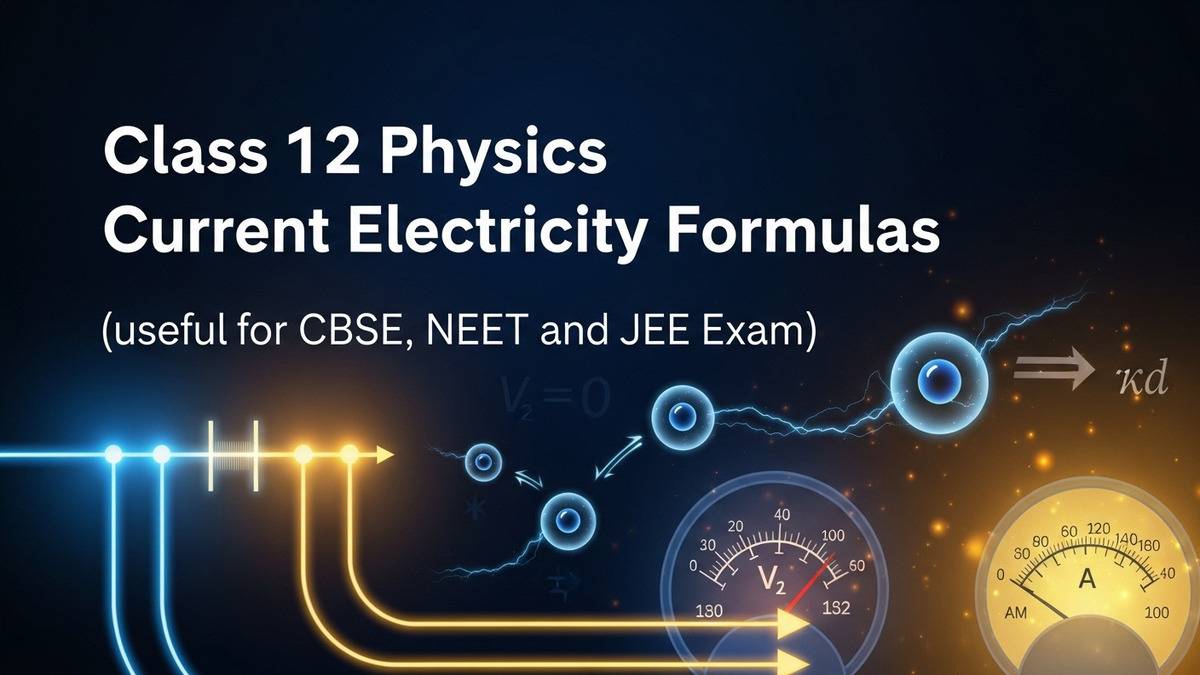Class 12 Physics Current Electricity Formulas
Learn all important Current Electricity Class 12 formulas to solve problems quickly and get the best results. All important formulas - Electric current, Resistance, Resistivity, Conductivity, and others are available on the page.
It is really important for Board and competitive exam students to have formulas on their fingertips during the exam. We at Shiksha have created a complete list of all the Current Electricity formulas for Class 12 to help you score full marks in the chapter.
Find the concise Class 12 Physics Chapter 3 formulas list for quick and last-minute revision during exams. Practice important numerical problems related to drift velocity, Ohm’s Law, resistivity, Kirchhoff’s laws, and other topics using these formulas.
You can combine chapter-wise NCERT Solutions and Notes provided by Shiksha with this formulas list to get the best results.
- Electric Current
- Ohm's Law: Resistance, Resistivity, and Conductivity
- Drift Velocity and Related Concepts
- Temperature Dependence of Conductivity, Resistivity, and Resistance
- Electrical Energy and Power
- Electric Cell: Electromotive Force, Internal Resistance, and Combination
- Kirchhoff's Laws
- Wheatstone Bridge
- Representation:
Electric Current
-
It is the rate of flow of charge per unit time through the conductor (wire).
Ohm's Law: Resistance, Resistivity, and Conductivity
It states that the potential difference across the terminals of the conductor will be directly proportional to the current.
Resistance: A property of a conductors that oppose the flow of charge.
Ohm's Law with properties of a wire
Current Density: It measures current per unit cross-sectional area of the wire.
Conductivity: It is the measure of the ability to conduct electric current through the wire.
Related useful formulas
Drift Velocity and Related Concepts
- Acceleration on Electrons (When an Electric Field (E) is applied)
- Drift Velocity
- Amount of charges passing through a wire in time Δt (cross-sectional area A)
- Current passing in Δt time
- Current Density (through the wire)
- Conductivity Formula (For properties of wire)
- Mobility: Drift velocity for per unit electric field applied
| Related Study Material for Class 12 Physics Current Electricity |
|---|
| Class 12 Physics Chapter 3 Quick Revision Notes |
| Current Electricity Class 12 NCERT Notes |
| Class 12 Current Electricity NCERT Solutions |
| Chapter 3 Current Electricity NCERT Exemplar Solutions |
Temperature Dependence of Conductivity, Resistivity, and Resistance
Resistance and resistivity are directly proportional to temperature. It means an increase in temperature will increase both of these and reduce conductivity ( since it is reciprocal of resistance).
- Effect of Temperature on Resistivity
- Effect of Temperature on Resistance
- Effect of Temperature on Conductivity
We know,
So,
If change in temperature is small,
Electrical Energy and Power
- Energy in t time:
- Power
Electric Cell: Electromotive Force, Internal Resistance, and Combination
- Electromotive Force
ε = Open-circuit voltage of the cell when no current flows
- Actual Terminal Voltage
- Current in the Circuit
- Combination of Cells
| Particulars | Cells in Parallel | Cells in Series |
|---|---|---|
| Total EMF | ||
| Total Internal Resistance | ||
| Current |
Kirchhoff's Laws
- Junction Rule: The sum of all currents entering a junction = the sum of currents leaving the junction.
- Loop Rule: The algebraic sum of changes in potentials in a closed loop is zero.
Wheatstone Bridge
-
When the measure of current in the galvanometer is zero.
Representation:
| Representation Symbols | |
|---|---|
| I = Current Q= Charge A = Cross-sectional area t = Time Δt = Small amount of time n = Number of electrons e = Charge of electron Vd = Drift velocity |
τ = Average relaxation time r = Internal resistance R = Circuit resistance ε = Electromotive force σ = Conductivity ρ = Resistivity j = Current density μ = Mobility |

